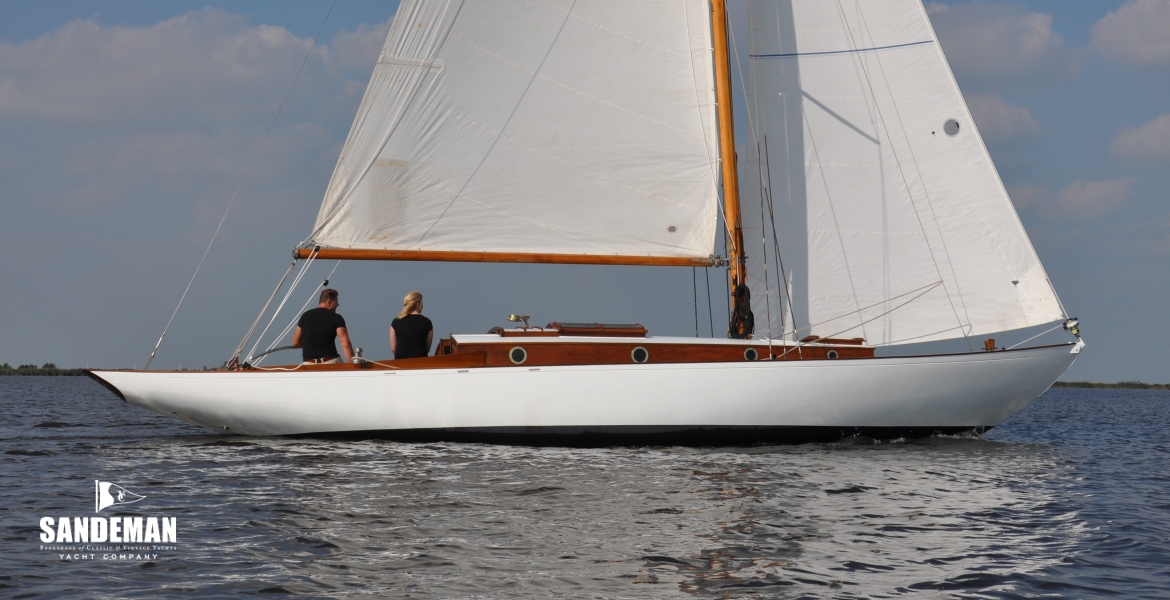
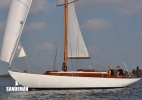
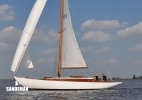

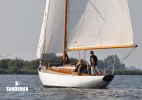
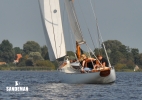
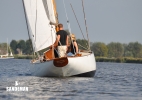
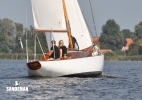
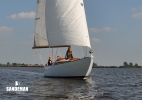
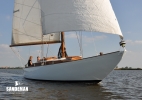
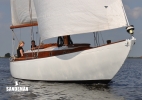
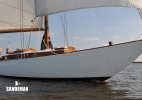
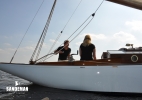
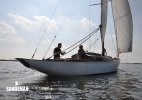
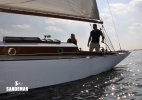
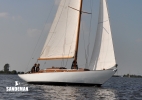
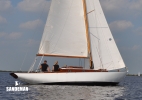
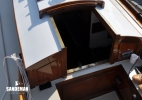
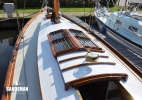
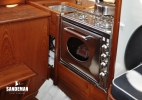

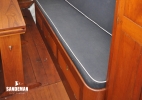
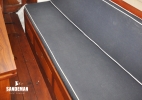
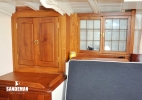
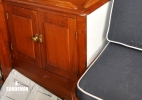
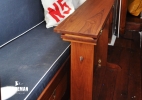
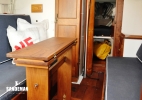

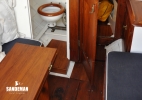
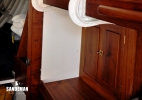
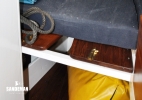

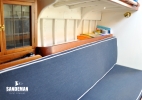
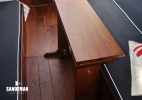
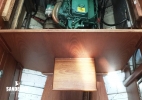
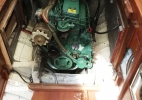
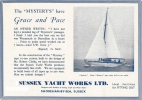
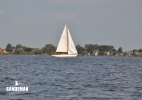
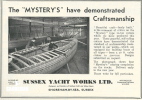
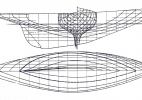
| Designer | Robert Clark |
|---|---|
| Builder | Sussex Yacht Works, Shoreham |
| Date | 1938 |
| Length overall | 39 ft 0 in / 11.88 m |
| Length deck | 39 ft 0 in / 11.88 m |
| Length waterline | 26 ft 6 in / 8.08 m |
|---|---|
| Beam | 9 ft 0 in / 2.74 m |
| Draft | 6 ft 5 in / 1.95 m |
| Displacement | 7.1 Tonnes |
| Construction | Carvel pitch pine and mahogany |
| Engine | Volvo Penta 3 cylinder 30hp (2003; 1st used 2014) |
|---|---|
| Location | Netherlands |
| Price | EUR 75,000 |
These details are provisional and may be amended
Something about Robert Clark’s Mystery Class yachts really catches the eye both at rest and at play. It’s about an enticing mix of elegance and simplicity – and scintillating performance under sail. Watching a Mystery work to windward like a perfectly-balanced, pre-radio control days model yacht is a wonder: they take you for a sail – over steering will just slow you down. NAIANDE has all of this, and in her rescue and restoration under present ownership has been kept true to period in all her understated elegance. This is what classic yachting should be all about.
Interested in NAIANDE in more detail.
NAIANDE had been laid up ashore for 20 years at a Kent pig farm when first viewed by her present owners, but through flaking paint and dust her good looks shone through, and on closer inspection she was in remarkable condition all things considered, with her mahogany and pitch pine hull planking and most of her frames good enough to save. After an initial start on her restoration themselves, NAIANDE was eventually entrusted to boatbuilders Heerlien & Adema of Workum on the Ijsselmeer for completion, which was achieved in 2014.
The work involved:
- Replacement of iron floors
- 1 x keelbolt replaced (2017)
- Part of stem and wood keel replaced
- New rudder
- A traditional process rehydration to allow “taking-up”
- Initially very loose underbody recaulking
- Some plank replacement and hood end repairs
- Above waterline seams routered and glue-splined
- Plywood deck glued and screwed over original red cedar deck
- Plywood skin over coachroof
- Plywood skin over cockpit sole
- New toe rail and capping rail
- New cockpit coaming to original drawings
- Reinstatement of mostly original interior
- New stainless steel chainplates
- Re-rigging
- Installation of a 2003 engine purchased by previous owner but never installed
Robert Clark and Sussex Yacht Works independently hit the ground running in 1936: Clark from complete obscurity but heavily endorsed by the powerful yachting press of the day; the yard from a greenfield site on the south bank of the River Adur, Shoreham-by-Sea, well funded by locally resident industrialist and yachting enthusiast Jack Rawlings - who would also become a significant client. By the outbreak of the Second World War, both businesses were seriously thriving household names in yachting with an astonishing level of output, especially of successful offshore racing yachts with names still famous today.
It was what became the Mystery Class that kick-started Clark’s career: a scaled down version of a 30ft/9.14m length waterline 2nd prize winner in a Yachting Monthly design competition. Clark was untrained, not yet in practice for himself and convalescing from a serious illness when he used a combination of intuition and crammed reading to come up with something very special. He was particularly influenced by Turner’s Metacentric Shelf theory for good balance and handling under sail, but clever enough to understand that this couldn’t be the only driving force in achieving a good all round design.
The first boat launched to the design was MYSTERY II, built by Moody of Swanwick in 1936, and from 1937 until 1946 Sussex Yacht Works would launch a further ten as the Mystery became quite the thing to have. They were possibly the first sailing yachts of this size to be built in series (with a break for a war) in the UK, but with no shirking in the use of the finest of materials: pitch pine and mahogany planking on a frame of oak, and teak coachroof sides, cockpit and coamings.
NAIANDE was built alongside the famous Clark-designed offshore racers ERIVALE and JOHN DORY during winter 1937-1938 to the order of Ian and Edna Spooner of beautiful Newton Ferrers on the River Yealm, east of Plymouth. Ian Spooner was Vice Captain of the Plymouth Division of Minima Yacht Club (in those days the Club had divisions at Kingston-on-Thames, Southampton and Plymouth). As with many yachts born just before the Second World War, they would have had little time to enjoy her. In naming her, the Spooners simply inverted their first names.
When sailing began again, NAIANDE had moved to the Thames Estuary under the ownership of Jack L. Wright of Rochester and is presumed to have been moored on the Medway. Under the 1951-1959 ownership of West Mersea Yacht Club member Vernon Powell, NAIANDE became a regular on the East Coast RORC offshore circuit: twice winner of the East Anglia Race and twice second in the Harwich-Hook of Holland Race.
Her next owner was medical microbiologist, very committed long distance cruiser and Cruising Association member Dr (later Professor) Brian Lacey, with NAIANDE taking him and his wife, still from a West Mersea base, cruising as far north as Gotland in Baltic Sweden and as far south as Atlantic Spain and Portugal, and into the Mediterranean.
Her present Dutch owners became only her 5th in 2006 and have given NAIANDE the new life she richly deserved. Who will become custodian number six?
©2025 Iain McAllister/ Sandeman Yacht Company Ltd.
- Pitch pine underbody and mahogany topsides planking on oak frame
- Pine and plywood deck and house roof
- Teak house sides, coamings, cockpit and toerail
- Steel floors
- Steel ring frames fore and aft of mast partners
- Stainless steel mast step
- Lead keel
From aft
- Teak toerail and capping rail, fashioned to attractive taffrail
- Mainsheet purchase
- Backstay purchases
- Stainless steel tiller
- Raised teak cockpit coaming and capping
- Engine control
- 2 x Modern self-tailing sheet winches
- 3 x Cockpit lockers under side decks
- Headsain sheet tracks and blocks
Coach house
- Teak sliding companionway hatch in garage
- Sestrel-Moore brass steering compass on garage
- Teak butterfly hatch
- Teak forehatch
- 4 x circular bronze framed ports each side
Foredeck
- Sampson post
- Bow rollers port and starboard of stemhead
Access via companionway aft of coach house, over short bridge deck
Interior joinery mostly teak
Teak sole
- Down one step onto engine box; further step to cabin sole
- Galley to port
- Three-burner stainless steel gimballed hob and oven (2010)
- Stainless steel sink with pressure cold faucet
- Stowage under sink
- Stowage aft to port under side deck & on shelf
- Stowage locker outboard with plate racks above
- Grab rails at carlins port and starboard
- Quarter berth to starboard
- Portable chart board
Moving forward
- Full height hanging locker to starboard
Saloon
- Cushioned settee berths port and starboard
- Stowage under accessed from side
- Upholstered settee backrests, stowage behind
- To port outboard of seat back: shelf
- To starboard above seat back: leaded glass cabinet fwd; fiddled shelf aft
- Saloon table (2014)
- Full length grab rails at carlins port and starboard
Moving forward
- To port, folding door to wc compartment with original Baby Blake manual toilet
- To Starboard, sideboard with fiddles, lockers under and outboard
Forepeak
- 2 x Berths with insert to make double
- Chain locker forward
- Believed original spruce mast and roller furling boom
- All rigging renewed 2017
- Profurl headsail furler
- Mainsail and roller furling genoa
MECHANICAL
- Volvo Penta 3 cylinder 30hp Diesel (2003 - 1st used 2014)
Sailing photos by Ron Valent
Contact us to discuss NAIANDE in more detail.
These particulars have been prepared from information provided by the vendors and are intended as a general guide. The purchaser should confirm details of concern to them by survey or engineers inspection. The purchaser should also ensure that the purchase contract properly reflects their concerns and specifies details on which they wish to rely.